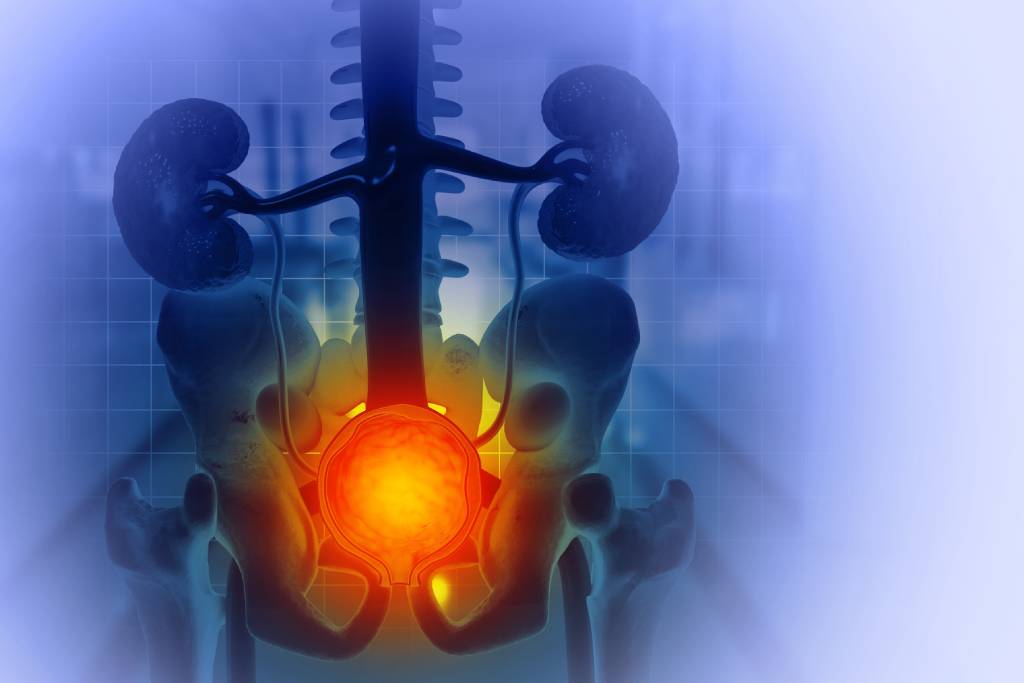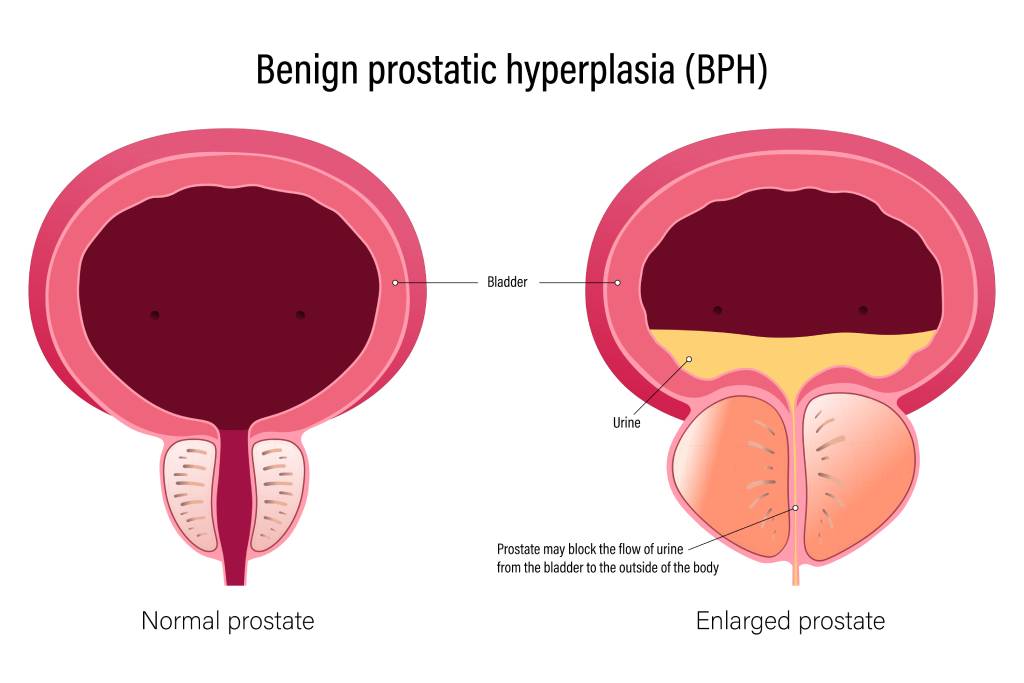An enlarged prostate, or benign prostatic hyperplasia (BPH), causes urinary problems such as frequent urination, weak stream, urgency, and incomplete emptying. Signs include elevated PSA levels, changes on a digital rectal exam, and imaging results. While not cancer, untreated BPH can cause infections, bladder stones, and kidney damage, but medications and minimally invasive treatments are available.
- Common symptoms: Frequent urination, urgency, weak stream, incomplete emptying, discomfort, erectile issues
- Signs doctors detect: Enlarged prostate via exam, high PSA levels, imaging confirmation
- Causes: Age-related prostate growth, hormonal and cellular changes
- Complications: UTIs, bladder stones, kidney problems if untreated
- Treatments: Lifestyle changes, medications, minimally invasive options (TULSA-PRO, FLA), or surgery
What are the symptoms and signs of an enlarged prostate? Common symptoms of an enlarged prostate, meaning issues that patients experience, include:
- Urinary symptoms, such as
- Increased frequency of urination
- A weak or inconsistent stream when urinating
- Increased urgency to urinate
- Feeling as if the bladder has not emptied after urinating
- Erectile dysfunction
- Pain or discomfort in and around the prostate
Signs of an enlarged prostate, meaning things that indicate an enlarged prostate and that health professionals and others can notice or detect in patients, include:
- An enlarged prostate detected through a digital rectal exam (DRE)
- Elevated levels found on a prostate-specific antigen (PSA) test
These are not the only symptoms and signs of prostate enlargement, but they are some of the more common ones.
For men experiencing these issues, common questions include, “What is causing these symptoms?” and “How can an enlarged prostate be treated?”
Keep reading to learn more about common signs and symptoms of an enlarged prostate, the medical cause of these symptoms, answers to frequently asked questions about enlarged prostates, and, most importantly, options for treating an enlarged prostate.
What Causes an Enlarged Prostate?
What is an Enlarged Prostate?
The term enlarged prostate generally refers to benign prostatic hyperplasia (BPH), a condition characterized by the excess, noncancerous enlargement of the prostate gland.
BPH generally causes quality-of-life issues, such as interfering with the flow of urine. However, this condition can lead to more serious issues, like urinary tract infections, need to use catheters to empty the bladder, and kidney damage, when left untreated.
BPH and prostate cancer share certain signs, like an elevated PSA level, and symptoms, like certain urinary issues. However, BPH and prostate cancer are distinct conditions. Imaging tests, biopsies, and close consideration of a patient’s symptoms, signs, and medical and family history can support physicians in making an accurate diagnosis.
Understanding BPH
BPH is common in men over 50, and the risk of this condition increases with age.
As the Urology Care Foundation explains, the prostate goes through a growth period that starts around age 25 and continues throughout most of the rest of men’s lives. With BPH, prostate growth is excessive, causing the prostate to press on the urethra. The bladder wall thickens, and issues such as incomplete emptying of the bladder and a weak urinary stream can occur.
The exact cause of BPH is unknown, but Penn Medicine points out that changes in the body as men age and, specifically, changes to the cells in the testicles can contribute to this excessive prostate growth. Age-related variations in testosterone levels may also play a role in BPH.
Common Signs and Symptoms of Prostate Enlargement
Signs of Enlarged Prostate (BPH)
As we mentioned previously, signs in medicine are observable indicators of a medical condition. Healthcare professionals, friends and family members, and patients themselves can notice medical signs depending on their exact nature. Physicians use tests and diagnostic tools to determine the presence of some signs that can’t be detected by a visual or physical exam.
Potential signs of BPH include:
- Elevated prostate-specific antigen levels. Elevated PSA levels can indicate certain prostate-related issues, including BPH and prostate cancer. An elevated BPH level can indicate that more testing is needed, as BPH is possible but not conclusively proven.
- Certain results of a digital rectal exam. While not conclusive on its own to confirm BPH versus other causes of an inflamed or larger-than-normal prostate, a DRE can identify certain signs of BPH. These include prostate enlargement, lack of tenderness, and loss of the prostate’s median furrow, as the Merck Manuals point out.
- Medical imaging results. An ultrasound or MRI can measure the size of the prostate and provide more context to physicians.
Symptoms of Enlarged Prostate (BPH)
Symptoms of an enlarged prostate are subjective issues experienced by patients with this condition. Despite their subjective nature, they can provide useful context for healthcare professionals in the diagnostic process. Symptoms of an enlarged prostate include:
- Frequent urination. The need to urinate frequently may indicate BPH, among other issues. Nocturia, the need to frequently urinate at night, is a related symptom.
- Urgent need to urinate. A sudden, pressing, and hard-to-control urge to urinate can be a symptom of BPH as well as other medical issues.
- Delayed onset of urination. Difficulty with starting to urinate can be a result of the prostate constricting the urethra due to BPH.
- Weak or shallow urine stream. A weak or shallow stream can be another indication of BPH interfering with the regular function of the bladder and urethra. Low pressure or dribbling at the end of urination is a similar symptom.
- Incomplete emptying of the bladder. A continued feeling that the bladder isn’t empty, even after urinating, may be an indication of BPH or another medical issue. Eventually, the bladder can be damaged to the point where catheters are required to empty the bladder.
- Pain and discomfort. Pain or discomfort in and around the area of the prostate isn’t a symptom exclusive to BPH, but can indicate its presence.
- Sexual and erectile dysfunction. Although BPH doesn’t directly cause erectile or sexual dysfunction, the presence of various urinary symptoms can lead to anxiety and other mental health concerns that negatively impact erectile function and intimacy.
- Urinary tract infections. The incomplete bladder emptying and urinary retention that BPH can cause may lead to urinary tract infections as stagnant urine remains in the bladder.
- Bladder stones. When urine doesn’t empty completely from the bladder, it can sit in the bladder. The minerals present in urine can then crystallize and form bladder stones. Bladder stones don’t exclusively indicate BPH, but are a possible symptom of this condition.
Treatment Options for BPH, Including Minimally Invasive Options
BPH can be treated in many ways, depending on the severity of its symptoms. In cases where the prostate is enlarged but does not cause quality-of-life issues, watchful waiting (medical monitoring without immediate intervention) and lifestyle changes may be all that’s needed.
In cases where issues caused by BPH are more severe, treatment options include:
- Medications, such as alpha blockers and 5-alpha-reductase inhibitors.
- Traditional and invasive surgical options, such as transurethral resection of the prostate (TURP).
- Minimally invasive treatments, including transurethral ultrasound ablation (TULSA-PRO) and focal laser ablation (FLA). These treatments use ultrasound or laser energy to remove affected tissue and avoid some of the issues that can occur with invasive surgical procedures, such as blood loss. Learn more about minimally invasive BPH treatment options.
Frequently Asked Questions About Enlarged Prostates
How Can a Man Tell if His Prostate is Enlarged?
Common signs of an enlarged prostate (i.e., BPH) include trouble starting to urinate, a weak stream of urine, and needing to urinate more often, especially at night. Physical exams, medical imaging, and PSA tests can serve as signs of an enlarged prostate to physicians. These processes help physicians diagnose BPH or decide if another medical issue may be the cause.
What Are the First Symptoms of Enlarged Prostate Problems in Men?
Typically, although not always, the first symptoms of an enlarged prostate in men are related to urination. Hesitation or difficulty when starting to urinate, a need to urinate more frequently than usual, and feeling as if the bladder hasn’t emptied completely are examples. In some cases, men may first notice other symptoms or not notice any symptoms of an enlarged prostate.
What Could Be Mistaken for an Enlarged Prostate?
As Johns Hopkins Medicine explains, other medical issues can cause symptoms similar to those of BPH. The symptoms of prostatitis (inflammation of the prostate and distinct from BPH), urinary tract infections, early-stage prostate cancer, and other medical conditions can, but don’t always, overlap with the symptoms of BPH.
This potential overlap in symptoms makes screening and evaluation by a medical professional especially important for identifying the cause of symptoms and receiving relevant treatment.
What is the 5-Second Exercise to Shrink the Prostate?
There is no exercise that can shrink the prostate or treat BPH. However, Kegel exercises, which involve contracting the pelvic floor muscles for about 3-5 seconds and then relaxing them for the same amount of time across several repetitions and sets, can help improve bladder control. Remember that this is an exercise to address a potential BPH symptom and not treat BPH itself.
Does Caffeine Affect an Enlarged Prostate?
Caffeine can both increase urine production and increase the urge to urinate, which can cause symptoms of BPH to worsen. Although caffeine doesn’t directly affect the prostate itself, it can make BPH symptoms more intense. Reducing caffeine intake by cutting down on caffeinated coffee, tea, and energy drinks can help to increase comfort.
Minimally Invasive Treatment Options for BPH
Prostate Laser Center offers MRI-guided, minimally invasive treatment options for BPH to qualifying patients, including FLA and TULSA-PRO. Learn more about treatment options for BPH.
NOTE: The information provided on this website is general medical information and does not establish a physician-patient relationship. Please discuss your particular situation with a qualified medical professional.


